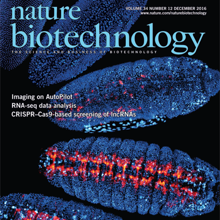Filter
Associated Lab
Publication Date
- Remove October 31, 2016 filter October 31, 2016
- Remove October 2016 filter October 2016
- Remove 2016 filter 2016
Type of Publication
3 Publications
Showing 1-3 of 3 resultsOptimal image quality in light-sheet microscopy requires a perfect overlap between the illuminating light sheet and the focal plane of the detection objective. However, mismatches between the light-sheet and detection planes are common owing to the spatiotemporally varying optical properties of living specimens. Here we present the AutoPilot framework, an automated method for spatiotemporally adaptive imaging that integrates (i) a multi-view light-sheet microscope capable of digitally translating and rotating light-sheet and detection planes in three dimensions and (ii) a computational method that continuously optimizes spatial resolution across the specimen volume in real time. We demonstrate long-term adaptive imaging of entire developing zebrafish (Danio rerio) and Drosophila melanogaster embryos and perform adaptive whole-brain functional imaging in larval zebrafish. Our method improves spatial resolution and signal strength two to five-fold, recovers cellular and sub-cellular structures in many regions that are not resolved by non-adaptive imaging, adapts to spatiotemporal dynamics of genetically encoded fluorescent markers and robustly optimizes imaging performance during large-scale morphogenetic changes in living organisms.
Actin assembly and inward flow in the plane of the immunological synapse (IS) drives the centralization of T cell receptor microclusters (TCR MCs) and the integrin leukocyte functional antigen 1 (LFA-1). Using structured-illumination microscopy (SIM), we show that actin arcs populating the medial, lamella-like region of the IS arise from linear actin filaments generated by one or more formins present at the IS distal edge. After traversing the outer, Arp2/3-generated, lamellipodia-like region of the IS, these linear filaments are organized by myosin II into antiparallel concentric arcs. Three-dimensional SIM shows that active LFA-1 often aligns with arcs, whereas TCR MCs commonly reside between arcs, and total internal reflection fluorescence SIM shows TCR MCs being swept inward by arcs. Consistently, disrupting actin arc formation via formin inhibition results in less centralized TCR MCs, missegregated integrin clusters, decreased T-B cell adhesion, and diminished TCR signaling. Together, our results define the origin, organization, and functional significance of a major actomyosin contractile structure at the IS that directly propels TCR MC transport.
Naïve Bayes Nearest Neighbour (NBNN) is a simple and effective framework which addresses many of the pitfalls of K-Nearest Neighbour (KNN) classification. It has yielded competitive results on several computer vision benchmarks. Its central tenet is that during NN search, a query is not compared to every example in a database, ignoring class information. Instead, NN searches are performed within each class, generating a score per class. A key problem with NN techniques, including NBNN, is that they fail when the data representation does not capture perceptual (e.g. class-based) similarity. NBNN circumvents this by using independent engineered descriptors (e.g. SIFT). To extend its applicability outside of image-based domains, we propose to learn a metric which captures perceptual similarity. Similar to how Neighbourhood Components Analysis optimizes a differentiable form of KNN classification, we propose 'Class Conditional' metric learning (CCML), which optimizes a soft form of the NBNN selection rule. Typical metric learning algorithms learn either a global or local metric. However, our proposed method can be adjusted to a particular level of locality by tuning a single parameter. An empirical evaluation on classification and retrieval tasks demonstrates that our proposed method clearly outperforms existing learned distance metrics across a variety of image and non-image datasets.

